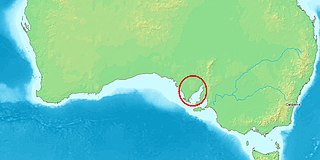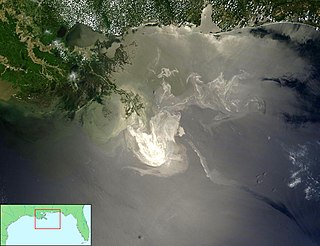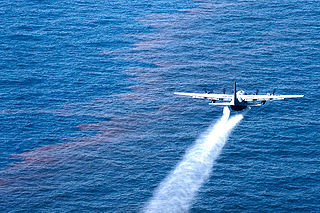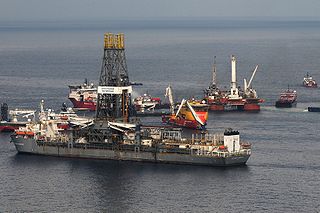
The Exxon Valdez oil spill was a major environmental disaster that occurred in Alaska's Prince William Sound on March 24, 1989. The spill occurred when Exxon Valdez, an oil supertanker owned by Exxon Shipping Company, bound for Long Beach, California, struck Prince William Sound's Bligh Reef, 6 mi (9.7 km) west of Tatitlek, Alaska at 12:04 a.m. The tanker spilled more than 10 million US gallons (240,000 bbl) of crude oil over the next few days.

An oil spill is the release of a liquid petroleum hydrocarbon into the environment, especially the marine ecosystem, due to human activity, and is a form of pollution. The term is usually given to marine oil spills, where oil is released into the ocean or coastal waters, but spills may also occur on land. Oil spills can result from the release of crude oil from tankers, offshore platforms, drilling rigs, and wells. They may also involve spills of refined petroleum products, such as gasoline and diesel fuel, as well as their by-products. Additionally, heavier fuels used by large ships, such as bunker fuel, or spills of any oily refuse or waste oil, contribute to such incidents. These spills can have severe environmental and economic consequences.

The Spencer Gulf is the westernmost and larger of two large inlets on the southern coast of Australia, in the state of South Australia, facing the Great Australian Bight. It spans from the Cape Catastrophe and Eyre Peninsula in the west to Cape Spencer and Yorke Peninsula in the east.

Port Bonython is the location of a deepwater port, gas fractionation plant and diesel storage facility west of Point Lowly in the Upper Spencer Gulf region of South Australia. It lies 16 km east-northeast of Whyalla, South Australia and approximately 370 km north-west of the State's capital city, Adelaide. The existing wharf is 2.4 kilometres long and is capable of berthing small Capesize ships with a maximum capacity of 110,000 tonnes. The wharf was established in 1982 and named after John Bonython, the founding chairman of Santos. The structure is leased to Santos by the Government of South Australia and is used for the export of hydrocarbon products. An oil spill at Port Bonython in 1992 resulted in loss of bird life and damage to mangrove habitats to the west and southwest of Port Pirie.

The Montara oil spill was an oil and gas leak and subsequent slick that took place in the Montara oil field in the Timor Sea, off the northern coast of Western Australia. It is considered one of Australia's worst oil disasters. The slick was released following a blowout from the Montara wellhead platform on 21 August 2009, and continued leaking until 3 November 2009, when the leak was stopped by pumping mud into the well and the wellbore cemented thus "capping" the blowout. The West Atlas rig is owned by the Norwegian-Bermudan Seadrill, and operated by PTTEP Australasia (PTTEPAA), a subsidiary of PTT Exploration and Production (PTTEP) which is in turn a subsidiary of PTT, the Thai state-owned oil and gas company was operating over on adjacent well on the Montara platform. Houston-based Halliburton was involved in cementing the well. The Montara field is located off the Kimberley coast, 250 km (160 mi) north of Truscott airbase, and 690 km (430 mi) west of Darwin. Sixty-nine workers were safely evacuated from the West Atlas jackup drilling rig when the blowout occurred.

The 2010 oil spill from Deepwater Horizon was an environmental disaster off the coast of the United States in the Gulf of Mexico, on the BP-operated Macondo Prospect. It is considered the largest marine oil spill in the history of the petroleum industry and estimated to be 8 to 31 percent larger in volume than the previous largest, the Ixtoc I oil spill, also in the Gulf of Mexico. Caused in the aftermath of a blowout and explosion on the Deepwater Horizon oil platform, the United States federal government estimated the total discharge at 4.9 million barrels. After several failed efforts to contain the flow, the well was declared sealed on 19 September 2010. Reports in early 2012 indicated that the well site was still leaking. The Deepwater Horizon oil spill is regarded as one of the largest environmental disasters in world history.

Corexit is a product line of oil dispersants used during oil spill response operations. It is produced by Nalco Holding Company, an indirect subsidiary of Ecolab. Corexit was originally developed by the Standard Oil Company of New Jersey. Corexit is typically applied by aerial spraying or spraying from ships directly onto an oil slick. On contact with the dispersant, oil that would otherwise float on the surface of the water is emulsified into tiny droplets and sinks or remains suspended in the water. In theory this allows the oil to be more rapidly degraded by bacteria (bioremediation) and prevents it from accumulating on beaches and in marshes.
The Sea Empress oil spill occurred at the entrance to the Milford Haven Waterway in Pembrokeshire, Wales on 15th February 1996. The Sea Empress was en route to the Texaco oil refinery near Pembroke when she became grounded on mid-channel rocks at St. Ann's Head. Over the course of a week, she spilt 72,000 tons of crude oil into the sea. The spill occurred within the Pembrokeshire Coast National Park – one of Europe's most important and sensitive wildlife and marine conservation areas. It was Britain's third largest oil spillage and the twelfth largest in the world at the time.

The Rena oil spill occurred off the coast of Tauranga, New Zealand in October 2011. The spill was caused by the grounding of MV Rena on the Astrolabe Reef. The Rena was a container ship and cargo vessel owned by the Greek shipping company Costamare Inc., through one of its subsidiary companies Daina Shipping. The spill has been described as New Zealand's worst maritime environmental disaster.

The Amoco Cadiz oil spill took place on 16 March 1978, when the oil tanker Amoco Cadiz, owned by the American petroleum company Amoco, ran aground on Portsall Rocks, 2 km (1.2 mi) from the coast of Brittany, France. The vessel ultimately split in three and sank. The US National Oceanic and Atmospheric Administration (NOAA) estimates that the total oil spill amounted to 220,880 tonnes of oil which amounts to over 58 million gallons or 256.2 million litres, making it the largest oil spill of its kind at the time.
The SS Wafra oil spill occurred on 27 February 1971, when SS Wafra, an oil tanker, ran aground while under tow near Cape Agulhas, South Africa. Approximately 200,000 barrels of crude oil were leaked into the ocean. The larger part of the ship was refloated, towed out to sea, and then sunk by the South African Air Force to prevent further oil contamination of the coastline.

An oil dispersant is a mixture of emulsifiers and solvents that helps break oil into small droplets following an oil spill. Small droplets are easier to disperse throughout a water volume, and small droplets may be more readily biodegraded by microbes in the water. Dispersant use involves a trade-off between exposing coastal life to surface oil and exposing aquatic life to dispersed oil. While submerging the oil with dispersant may lessen exposure to marine life on the surface, it increases exposure for animals dwelling underwater, who may be harmed by toxicity of both dispersed oil and dispersant. Although dispersant reduces the amount of oil that lands ashore, it may allow faster, deeper penetration of oil into coastal terrain, where it is not easily biodegraded.
Sanko Harvest was a 32,502 DWT dry bulk carrier that sank off Esperance, Western Australia after striking a charted reef on 14 February 1991. The Korean-crewed Japanese-owned ship was 174 metres (571 ft) long and was carrying a cargo of 32,790 tonnes of phosphate fertilizer valued at A$8.9 million. Also on board were 677 tonnes of heavy bunker fuel and 40 tonnes of light diesel oil.

The Health consequences of the Deepwater Horizon oil spill are health effects related to the explosion of the Deepwater Horizon offshore drilling rig in the Gulf of Mexico on April 20, 2010. An oil discharge continued for 84 days, resulting in the largest oil spill in the history of the petroleum industry, estimated at 206 million gallons. The spill exposed thousands of area residents and cleanup workers to risks associated with oil fumes, particulate matter from Controlled burns, volatile organic compounds (VOCs), polycylic aromatic hydrocarbons (PAHs), and heavy metals.

The Deepwater Horizon oil spill occurred between 10 April and 19 September 2010 in the Gulf of Mexico. A variety of techniques were used to address fundamental strategies for addressing the spilled oil, which were: to contain oil on the surface, dispersal, and removal. While most of the oil drilled off Louisiana is a lighter crude, the leaking oil was of a heavier blend which contained asphalt-like substances. According to Ed Overton, who heads a federal chemical hazard assessment team for oil spills, this type of oil emulsifies well. Once it becomes emulsified, it no longer evaporates as quickly as regular oil, does not rinse off as easily, cannot be broken down by microbes as easily, and does not burn as well. "That type of mixture essentially removes all the best oil clean-up weapons", Overton said.
Curlew Island is a low mangrove-dominated island located near the head of Spencer Gulf, South Australia. It lies between Port Augusta and Point Lowly and is adjacent to the Playford B Power Station. Several ships ran aground in the shallow waters surrounding the island during the late 1800s and early 1900s. Several recreational boating accidents have also occurred in the vicinity. The locality is known for its fishing and for occasional whale sightings in the winter.
The MT Castillo de Bellver oil spill began on 6 August 1983, when the Spanish tanker caught on fire off Saldanha Bay, approximately 70 miles northwest of Cape Town, South Africa. It was carrying 250,000 tonnes of light crude oil, and was traveling through an environmentally sensitive area known for its seabird rookeries and important commercial fishing grounds. The burning vessel was abandoned and broke apart after drifting offshore. Three crew were lost. The stern capsized and sunk and the bow was sunk using explosives. A total of 145,000-170,000 tonnes of oil entered the sea. Onshore impacts were considered negligible as the slick traveled seaward. The only visible impact was the oiling of 1,500 gannets that were on a nearby island.
Port Bonython Fuels is a fuel importation and diesel distribution hub at Port Bonython on the Point Lowly peninsula in South Australia's upper Spencer Gulf region. The development was designed to supply the State's expanding oil, gas and mineral resources sectors' operations in the north and west of the state. It allows South Australia to import fuel from ships carrying cargoes in excess of 100,000 tonnes- approximately four times the size of vessels currently importing diesel via Port Adelaide. The project is owned by Petro Diamond Australia, a wholly owned subsidiary of Mitsubishi Corporation. The first stage of the project was officially opened in May 2016.

Fitzgerald Bay is a large bay located between Point Lowly and Backy Point in South Australia's upper Spencer Gulf. The bay's shoreline consists mostly of pebble beaches and sparse grey mangroves. In the 2000s the bay was used for the farming of yellowtail kingfish until their closure circa 2011 in response to high levels of fish mortality. Understanding of the environmental impacts of yellowtail kingfish farming is limited. As of 2021, fish farming has not returned to Fitzgerald Bay, but aquaculture zones remain in place, and Clean Seas is authorised to restock fish farms there. There are approximately forty shacks and coastal homes sparsely distributed along the fringe of Fitzgerald Bay whose interests are represented by the Cultana Jenkins Shackowners' Association.

Böhlen or Boehlen was an East German oil tanker that sank during a storm off the Île de Sein on 14 October 1976, causing the death of 25 crew members and an oil slick on the coast of mainland Finistère and the Île de Sein. Three other people died in the operations to pump and clean up the oil from the Böhlen.













